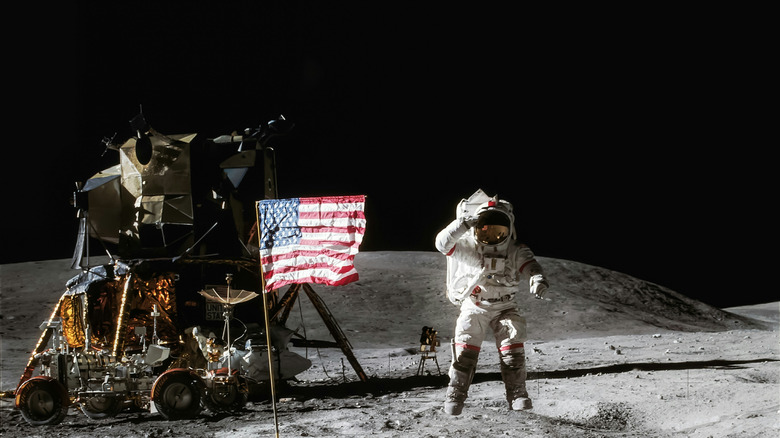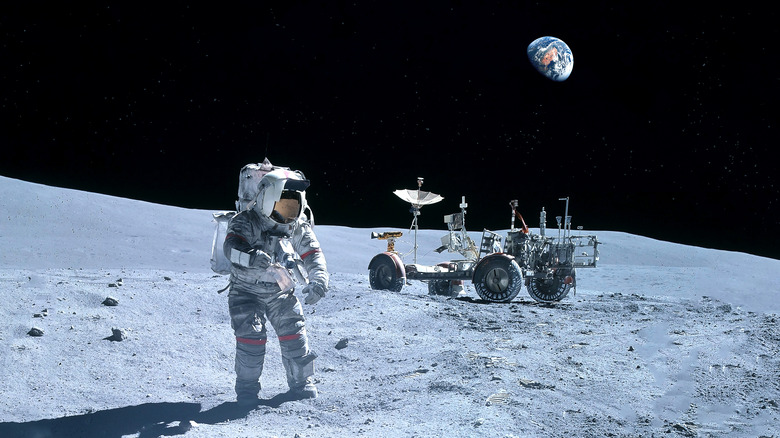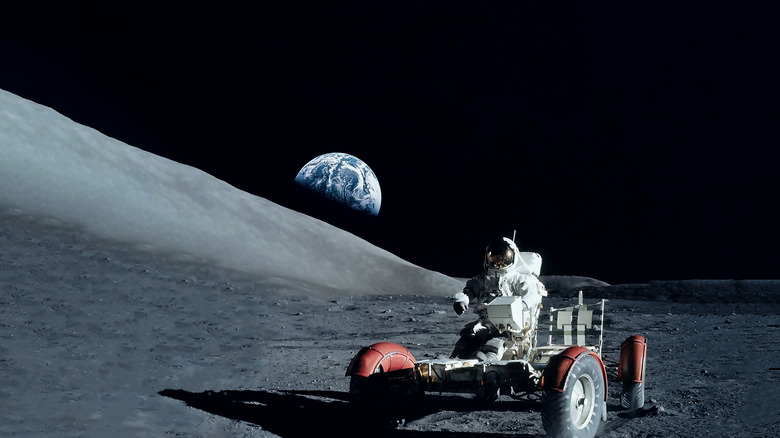The Star Theory That Some People Think Proves The Moon Landing Was Fake
What is it about moon landing conspiracy theories? The question of whether or not NASA actually successfully landed a crew of astronauts on the moon might be an interesting one, but does it actually affect your day-to-day life? Despite how little it seems to matter, there is an almost shockingly huge number of people who have devoted their lives to not believing the moon landings happened.
Why would we have faked the moon landings? The story goes that NASA had wasted untold millions of dollars on research and development, realized there was just no way to make it to the moon, and decided they needed to save face in front of the Russians and the American public. And since there were apparently no other ways to make a display of America's power — NASA had presumably forgotten that the atomic bomb existed — they resolved to fake the whole thing. So they hired (in most versions) director Stanley Kubrick to film it on a soundstage (via Rolling Stone). Why Kubrick? Presumably, because he had shown a considerable aptitude for faking spacey things in "2001: A Space Odyssey." Or else, people at NASA were just big "Dr. Strangelove" fans. We might never know.
To be clear, we have no compelling evidence the moon landing didn't happen and an awful lot of evidence that it did. We have more than 800 pounds of rock that have been brought back (via NASA). We left behind "retroreflectors" — sort of like the ones they put along the highway — that independent researchers have been bouncing lasers against for research purposes for decades. At least until the reflectors got a bit too covered in moon dust, according to The New York Times.
Sorry, the moon landing was real
Further, both independent astronomers and the Soviet government tracked the Apollo missions (via Spaceflight Insider). And the U.S.S.R. has never tried to deny that the moon landing happened, despite having every conceivable political motivation to do so. Further, here's a YouTube video in which filmmaker S.G. Collins argues pretty convincingly that while the technology to go to the moon existed in the 1960s, the technology to fake it on film or videotape absolutely didn't.
No serious person would argue that the U.S. government never lies, but at a certain point, it becomes clear that the weight of evidence is absolutely on the side of a genuine moon landing. We have piles and piles of physical evidence in the form of video and photographs. And yet, the naysayers won't stop: The shadows in the photos are weird! You can see the flag waving in the breeze! And those brain-geniuses at NASA even forgot to put stars in their fake sky! What amateurs.
We can dispense with those first two objections pretty quickly. If there were really multiple light sources involved (as there would have been, had the photos been shot on a soundstage), you'd see multiple shadows for each object — not just one. If some objects appear partially lit from underneath (per History), it's because the moon reflects sunlight (that's why you can see it in the sky). And the flag actually doesn't flap in the breeze, which you can clearly see in the footage of its planting — as soon as the astronauts move away from it, it stops moving (via YouTube). But what of the lack of stars?
No, Sherlock, you can't see stars in the daytime
As for the lack of stars in the official photos, the answer is equally simple: the astronauts visited the moon in the daytime. You, being a genius who's too smart for the government, may have noticed you can't see the stars from the surface of Earth in the daytime, either. That's a little more complicated since Earth's atmosphere scatters sunlight and obscures them, but the principle is the same: The sun is literally trillions of times brighter than the stars, so its light will always overwhelm them (via Discover). That said, while it's possible to see the stars from the moon's surface in the daytime if you squint, anyone who's ever worked with a traditional film camera will understand why you can't see them in the official Apollo photos.
If you're taking photos in a low-light environment, you have to open your camera's aperture (the thing that lets light in) wider and increase the exposure time; if you're working in a low-light environment, you do the opposite. As it turns out, the sun is pretty bright, so the astronauts' cameras were set up with narrow apertures and short exposures, meaning dim light sources — like the stars — just didn't get a chance to make an impression on the film (via Discovery). As historian James Oberg (quoted in Science Focus) puts it, you won't see the stars in photos taken at a brightly lit nighttime football game, either, and yet we're almost positive football is real.
So there you have it. Short exposure time, no stars. Or else a team of literal space scientists bent on fooling the world somehow forgot there are stars in space. Your call.


